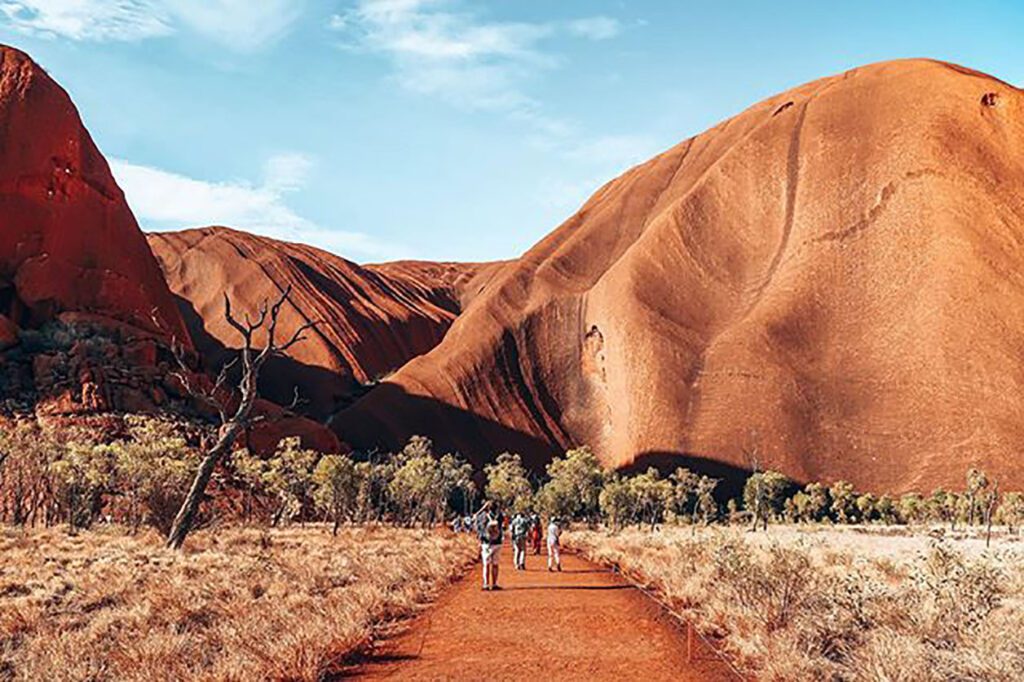Visiting Uluru is a rite of passage for all that live in or are visiting Australia. The sheer size of the monolith is awe-inspiring and the mystery that surrounds its origins add to the magic of the site. However, learning about how the rock came to be from a scientific perspective and diving into the cultural understanding of the Indigenous Australian’s experience only enriches your experience of this UNESCO World Heritage site.


A Little About Uluru
For those that don’t know, Uluru is a large rock that is made of sandstone found in Australia’s Northern Territory which was formed more than 530 million years ago. The rock has a height of more than 862 metres and the rock’s circumference is a little over 9.4 kilometers. Interestingly, most of the rock is situated underneath the ground with a subterranean section estimated to be deeper than 3 kilometers. The massive rock is sacred because of its important history, and many Aboriginal nations see Uluru as an important symbol that represents their land.
The Aboriginal’s Traditional Significance Of Uluru
Many groups have suggested that the rock is a symbol that represents the histories of numerous Aboriginal groups. Many nearby rocks also contain ancient rock art that was created during the last 30,000 years.
Why Is Uluru Important to Indigenous Australians?
Many Aboriginal citizens believe that the spirits of ancestors reside within the sizable rock. Therefore, Uluru is a sacred rock that must be protected by the Aboriginal groups and the Australian government.
The History of The Site
During the 1890s, many travelers visited Uluru, and after 1905, the area attracted experienced adventurers, enthusiastic hikers, many climbers and knowledgeable geologists. During the 20th century, many Australian citizens also studied the rock’s history and the area’s landscape. In the 1960s, several groups advocated for reasonable regulations that could protect the rock, and during 1964, experienced hikers installed the first chain that stabilized climbers.
Who Discovered Uluru?
Indigenous Australians found the rock more than 30,000 years ago with evidence of ancient stories describing the monolith’s history and rock art found in the surrounding area. However, until recently, the European colonial perspective was that William Gosse found Uluru on an expedition.
When Was Uluru Discovered?
The first non-Indigenous discovery of Uluru was documented in July 1873, and once several explorers visited the area, many surveyors explored the surrounding landscape.
The Rock’s Formation
Uluru’s formation is linked with the geological formation of Australia more than 515 million years ago. While the continent formed, many layers of sediment accumulated above the old seabed. Eventually, the heavy materials compressed the underlying sediment, so the lower sediment became solid rock. When the sand accumulated, the sediment also formed the conglomerate rock that is situated underneath the sandstone.
How Was Uluru Formed?
The rock formed underneath what was the Pacific Ocean, and most experts believe that water covered the rock for more than 20 million years. Over time, the water increased the level of pressure that affected the sandstone, and as a result, the water effectively hardened the sandstone. While the continent grew, the rock’s size increased as well.
Is Uluru the Biggest Rock in the World?
Before the 1890s, many Australians believed that Uluru was the biggest rock in the world. However, Mount Augustus is substantially larger than Uluru. This massive monolith has an area of more than 35 square miles and its height exceeds 1 kilometer.
The Impact of Erosion
Without a doubt the rock is steadily eroding due to strong winds and sunlight. Currently, the area receives low levels of rainfall but over the last 50,000 years the region received significant rainfall. The rain consistently eroded the rock, yet during the last 10,000 years, the dry climate may have reduced the speed of the erosion.
Interestingly, the rock’s outer section gradually became red during the last 150 million years. The heavy Australian sun slowly caused oxidation within the rock and as a result corrosion affected the materials that contain high levels of iron making the rock red.
On an Uluru base walk, you can see massive valleys that were created by erosion.


Discover Australia’s Red Centre with our Uluru Sacred Sites & Sunset tour.
How Will Uluru Change in the Future?
Gradually, the erosion will significantly enlarge the ravines, the valleys and the cliffs. The rock’s height may substantially decrease, but the subterranean section will remain large because erosion will not affect the underground rock.
How Can We Protect Uluru?
In order to the safeguard the rock, we can significantly reduce the number of individuals who climb the monolith. During October 2019, Australian officials decided to prevent travelers from climbing the rock as it is culturally insensitive to Indigenous Australians. By decreasing the number of climbers, the Australian officials can also help reduce erosion, safeguard the rock’s top layer and improve safety.
Interesting Facts About Uluru
Where Is Uluru?
Uluru is in the Northern Territory, Australia, and the monolith is located in the central section of a large reserve about 450 kilometres drive from Alice Springs.
What Does Uluru Mean?
To the local Indigenous people, the Anangu nation, Uluru means ‘great pebble’.
When Does Uluru Close?
During the summer months, the area closes at 8:30 p.m. every day. Throughout the winter months, guests can visit the area until 7:30 p.m.
Who Owns Uluru?
In 1985, the Australian government transferred ownership to the traditional custodians of the land, the Anangu nation.
Experience Uluru with AAT Kings
There is so much to experience on a tour to Uluru that you can easily miss without a guide. We recommend our Uluru sunset tour to enjoy the beautiful red landscape as the sun kisses the horizon. With a glass of champagne in hand, life cannot get much more mesmerising.
See more of our selection of guided Uluru tours.

